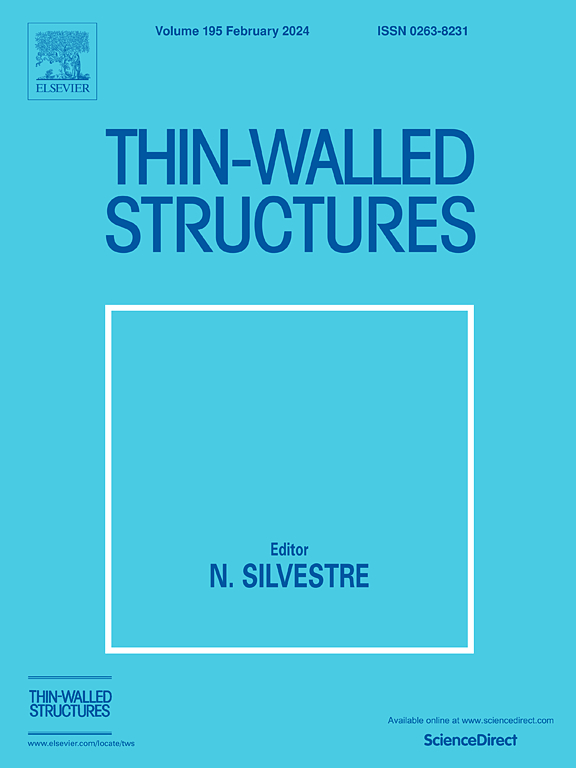Machine learning based multi-objective optimization on shear behavior of the inter-module connection
IF 5.7
1区 工程技术
Q1 ENGINEERING, CIVIL
引用次数: 0
Abstract
Prefabricated prefinished volumetric construction (PPVC) has become a research hotspot in recent years. Inter-module connections have a crucial influence on the mechanical behavior of PPVC. However, current studies on shear behavior and optimization design method of the inter-module connection are insufficient. This paper investigated shear behavior and machine learning based optimization method of an innovative fully bolted liftable connection (FBLC) for PPVC. The failure mode, force transferring mechanism, and ultimate load bearing capacity of the FBLC under shear force were revealed by the shear behavior tests. Four specimens were tested and the design parameters included the strength and number of the long stay bolts. Subsequently, a refined finite element model (FEM) of the FBLC was established and validated with the ratios of the shear bearing capacity between the FEA and test results ranging from 0.99 to 1.10. Then, six mainstream machine learning algorithms were utilized to predict shear behavior of the FBLC. The Genetic Algorithm Optimized Neural Network (GANN) provided better prediction accuracy on the shear bearing capacity, with an improvement on R2 by 0.1 % – 3 % compared with other algorithms. Similarly, the Support Vector Regression (SVR) showed higher prediction accuracy on the ultimate displacement, improving R2 by 0.4 % – 12.9 % compared with other algorithms. A stacking algorithm combing the GANN and SVR was developed as the proxy model between the input variables and optimization metrics. In addition, the NSGA-II algorithm was linked to establish a multi-objective optimization method on shear behavior of the FBLC. The yield load, ultimate load and steel consumption were selected as the optimization objectives and the stacking algorithm was used as the proxy model. The Pareto optimal solution sets on the optimization objectives were explored by the NSGA-II algorithm and the optimization design method of the FBLC was established. Compared with the unoptimized specimen, the yield and ultimate shear bearing capacity of the optimized specimen were increased by 113.5 % and 123.6 %, respectively, with the steel consumption reduced by 26.3 %. Finally, a four-story PPVC was established, and the static analysis was carried out under vertical load and wind load. The shear behavior of the FBLC and inter-story drift ratio of the PPVC before and after optimization were compared to verify the reliability of the optimization method.
基于机器学习的多目标优化模块间连接的剪切行为
预制预成品体积建筑(PPVC)已成为近年来的研究热点。模块间连接对 PPVC 的力学性能有着至关重要的影响。然而,目前对模块间连接的剪切行为和优化设计方法研究不足。本文研究了 PPVC 创新全螺栓可升降连接(FBLC)的剪切行为和基于机器学习的优化方法。剪切行为试验揭示了 FBLC 在剪力作用下的破坏模式、传力机制和极限承载能力。测试了四个试样,设计参数包括长留螺栓的强度和数量。随后,建立并验证了 FBLC 的精细有限元模型(FEM),有限元分析与试验结果之间的剪切承载力比率为 0.99 至 1.10。然后,利用六种主流机器学习算法来预测 FBLC 的剪切行为。遗传算法优化神经网络(GANN)提供了更好的剪切承载力预测精度,与其他算法相比,R2 提高了 0.1 % - 3 %。同样,支持向量回归(SVR)对极限位移的预测精度更高,与其他算法相比,R2 提高了 0.4 % - 12.9 %。结合 GANN 和 SVR 开发了一种堆叠算法,作为输入变量和优化指标之间的代理模型。此外,还将 NSGA-II 算法与 FBLC 的剪切行为联系起来,建立了一种多目标优化方法。选择屈服载荷、极限载荷和钢材消耗作为优化目标,并使用堆叠算法作为代理模型。通过 NSGA-II 算法探索了优化目标的帕累托最优解集,并建立了 FBLC 的优化设计方法。与未优化试件相比,优化试件的屈服承载力和极限剪切承载力分别提高了 113.5 % 和 123.6 %,钢材消耗量减少了 26.3 %。最后,建立了一个四层的 PPVC,并在垂直荷载和风荷载下进行了静力分析。比较了优化前后 FBLC 的剪切行为和 PPVC 的层间漂移率,验证了优化方法的可靠性。
本文章由计算机程序翻译,如有差异,请以英文原文为准。
求助全文
约1分钟内获得全文
求助全文
来源期刊

Thin-Walled Structures
工程技术-工程:土木
CiteScore
9.60
自引率
20.30%
发文量
801
审稿时长
66 days
期刊介绍:
Thin-walled structures comprises an important and growing proportion of engineering construction with areas of application becoming increasingly diverse, ranging from aircraft, bridges, ships and oil rigs to storage vessels, industrial buildings and warehouses.
Many factors, including cost and weight economy, new materials and processes and the growth of powerful methods of analysis have contributed to this growth, and led to the need for a journal which concentrates specifically on structures in which problems arise due to the thinness of the walls. This field includes cold– formed sections, plate and shell structures, reinforced plastics structures and aluminium structures, and is of importance in many branches of engineering.
The primary criterion for consideration of papers in Thin–Walled Structures is that they must be concerned with thin–walled structures or the basic problems inherent in thin–walled structures. Provided this criterion is satisfied no restriction is placed on the type of construction, material or field of application. Papers on theory, experiment, design, etc., are published and it is expected that many papers will contain aspects of all three.
 求助内容:
求助内容: 应助结果提醒方式:
应助结果提醒方式:


